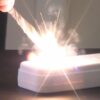Visit me at: http://www.ericthecarguy.com/
It’s actually quite common for these radiators to fail this way so if you own a Honda of this vintage I’m sure you’ll have to replace a radiator at some point. As the title says if it’s an Acura 2.3 CL or an Accord this procedure will work as they are both pretty much the same vehicle. Also as pointed out in the video probably the most critical part is to make sure you bleed the air out of the system properly. If you don’t bleed the air properly you can get a fluctuating idle, intermittent overheat, inconsistent heat, and possibly a water sloshing noise from the dashboard area. Be sure not to skip this important step anytime you open a cooling system to avoid these issues. Here are some links that were mentioned in the video.
Bleeding a Cooling System: http://www.youtube.com/watch?v=zUpXgAJ1gjU
Diagnosing an Overheat: http://www.youtube.com/watch?v=hUzOTnsWImI
Mitsubishi Radiator Replacement: https://www.youtube.com/watch?v=0myTOfrhozs
Spill Free Funnel: http://www.jbtoolsales.com/lisle-24610-spill-free-funnel-set/
Discussion about this video: https://www.ericthecarguy.com/kunena/18-The-EricTheCarGuy-Video-Forum/44431-how-to-replace-a-radiator-1999-acura-23claccord#55547
Stay Dirty
ETCG
Due to factors beyond the control of EricTheCarGuy, it cannot guarantee against unauthorized modifications of this information, or improper use of this information. EricTheCarGuy assumes no liability for property damage or injury incurred as a result of any of the information contained in this video. EricTheCarGuy recommends safe practices when working with power tools, automotive lifts, lifting tools, jack stands, electrical equipment, blunt instruments, chemicals, lubricants, or any other tools or equipment seen or implied in this video. Due to factors beyond the control of EricTheCarGuy, no information contained in this video shall create any express or implied warranty or guarantee of any particular result. Any injury, damage or loss that may result from improper use of these tools, equipment, or the information contained in this video is the sole responsibility of the user and not EricTheCarGuy.














![suspect for fraud in the 6th District [VIDEO] – Blotter](https://avnblogfeed.com/wp-content/uploads/2024/04/Fraud-6xx-N-11th-St-DC-24-06-003505-100x100.jpg)






AMAZINGLY DETAILED VIDEO!!! Thank you 🤣🤙
Yes finally a video where someone knows what they're doing and still drops a tool! Great recovery. Thank you for the videos you make.
I usually also squeeze the bottom and top hose a bit which helps get the air out. Great video . thanks Eric.
unlike the other videos on how to here, yours is by far the best!. it is easy to understand, and the camera isn't all shaky as some are like they just did a big line of "crank", and can't get their sequence down……
Thanks you Eric
Thank you for a very well done video, with easy to see viewing angles. Also, I liked how you talked through potential issues to avoid. I got a sense from those deep sighs that a lot people went through those exact issues. Keep it up!
It will be any problem if I use different coolant.
awesome tutorial. replaced my 99 accord radiator today after watching your video. saved me a lot of time and head scratching. transmission cooler lines details were appreciated and also taking out the radiator with the fans and swapping them onto the new one on the bench saved lots of time and made it easier than what I had in my head.
thanks !!! i guess i will have to wing the automatic part. nice tip on where to disconnect much appreciated!!! the kids rad cap was bad so i replaced and pressure was created so the heater hose blew and more pressure was created so the radiator blew and now am doing that. what is the next weak link:)
Awesome video. I swapped mine out today, first time. Thank you for your time
Eric I need your help. my car wasn't overheating nor did it overheat ever. I just started seeing fume coming from under the hood. saw bubbles coming from the radiator so I figured it was the radiator. changed it out and boom fume comes back. it has that weird hit water antifreeze smell to it. so I know it's related. can you please help me out and give me a suggestion. I am in dyer need thanks.
What size socket did you use for the bleeder valve
https://drive.google.com/open?id=0B1KeTY1KkUrsajhNUmRQWFc2YzQ
What's is this sensor and what does it do… I can't find anything on it and autozone and advance auto parts can't find the sensor in their data base I watch you video was having a hard time getting the air out of my car 99 Acura Cl then I seen this video I replace 3 out of the four sensor that sense the coolent all under the distributor and thermostat one on thermostat housing? But the one circle in red I don't know what it does look the same as the one on thermostat housing
Eric – thank you for doing this channel. I cannot tell you how informative your videos on late 90s/early 2000s Accords and Civics have been. I don't know how I would be doing radiator replacements, brake jobs, valve adjustments and other assorted maintenance otherwise.
This radiator job is very similar to doing this era (98-02) 4 cylinder Accord (4 door EX, KA 4AT), but there is no relay up top, and instead wires clipped across the top of the fans in three places you need to disconnect (the clips will probably snap, but zip ties should do fine). You will also be relieved to know that the cooling fan (on the right, when you have it laying down in front of you) is only bolted in at the top, so there are two few rusted nuggets you need to fight, just the one on AC, and two on the transmission line, if you have an automatic. It's probably worth watching the radiator video on the 99 Civic he did for other relevant advice on removing destroyed bolts from the bottom of the radiator. I often wind up using tin snips to cut up the plastic on the old radiator around where the destroyed bolts are on the bottom.
HOWEVER, if you have an automatic transmission, as I do, you will find "Pipe C (ATF)" is pointlessly there to connect one of your transmission cooling hoses to the radiator. If you live in the salt belt, as I do, you will likely find it rusted to hell, and perhaps in the process of rusting out, coated in transmission fluid. You may want to have the part on hand if you are doing this job. It is Honda part #25210-PAA-020. And yes, removing the hoses from the hard lines up top is the absolute only way to go.
Final tip – you may also want to replace the power steering cooling tube, part #53765-S84-A01, which is another metal tube, this one running behind the radiator, and impossible to do without either removing the radiator or possibly the splash shield. Mine rusted out last summer, and was leaking power steering fluid.
151k? I wonder if it's had transmission issues before.
Great tutorial Eric! What's a "good" brand radiator for a 2005 Acura TL automatic. Rock Auto has lots to choose from. Not sure if after market is a good idea. Your thoughts?
what about the hardlines to the engine cooler how did.yoi get those off?
why didn't you use pure coolant when adding it to the radiator is pure better and just do a 60/40 mixture
Thanks. Glad I found a video where someone is working on my exact car model
Question : Will 2000 honda accord door lock actuators fit a 2000 acura tl ?
Hey Eric, can you do a video on how to replace water pump, timing belt, the whole tune up deal for a 1999 acura cl? I assume 2.3 and 3.0 is pretty much the same?
Great great great job Erik. I picked up a tip on disconnecting the lower hose, to where you can just pull the radiator up and disconnect the hose standing up instead of on your back on the floor. Ciao for now, and keep those great videos coming.
Does this same procedure apply to the "98" Acura CL? Basically do they use the same radiator?
I believe my acrura cl type s did this to me last nite…that whole front by the fans is filled with this thick oil and it was smokin
Great job Eric, and thank you for taking your time to show us all how to change our radiator!
i have a 2001 dodge dakota 4.7l v8 and it overheats after about 30 minutes of driving and i have changed the thermostat and it still does it and it does not leak it still has good flow and has new antifreeze and disstilled water i think it is the radiator so i would like your professional opinion
Hello Mr. Car Guy. I have a 1998 Acura CL 2.3, and I just replaced my small leaking radiator around the top plastic trim. I noticed after you re-installed the new radiator, you raised the RPMs to verify the radiator fans for function-ability. When I tried on my vehicle, my fans would not come on; however, the temp gauge is mid ways cold and median temp. It's showing below average temp, but still neither fan comes on. When my car is cold with first start up, my temp gauge inside the vehicle is sitting on COLD, then idle to normal temp with the temp I described above. So, my gauge is functioning. Now with AC on both fans do run. I don't know if this is what caused me to have to do a radiator replacement this time. Please help! Advise………………..
In an auto transmission there are two hoses connected to the radiator. Will coolant drain out of the hoses after being disconnected and, if so, will the transmission lines have to be bled and refilled? Great video. Thanks!